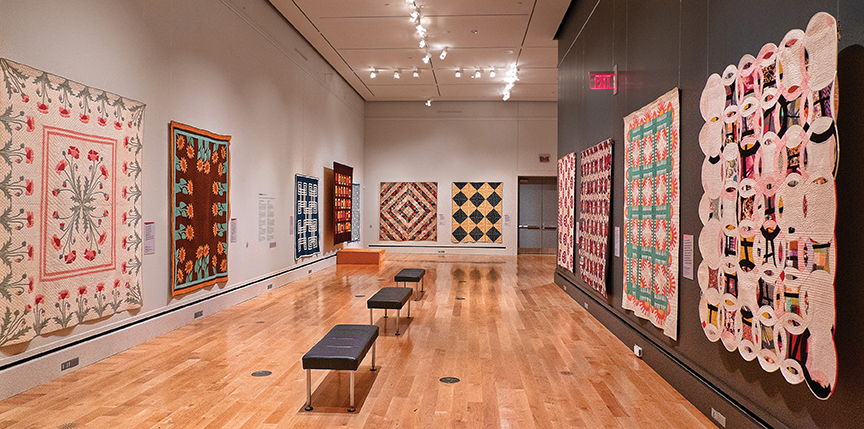International Quilt Museum – More than threads and cloth

by Aja Martin
The International Quilt Museum’s collection (internationalquiltmuseum.org) has quilts from all over the world and includes objects you might not even think of as quilts. It takes a familiar medium and illuminates it in different lights.
“Often times, when people hear the word quilt, they have an immediate response, a mental picture of what that means,” says Leslie Levy, Executive Director. “Other high or fine art is much less accessible to the public than quilts. They truly are an art form passed on from generation to generation. Because people have a particular context they view quilts in, they don’t realize what it can entail.”
It is the museum’s intention to change the dialogue around this art form.
It might come as a surprise to some, but like most projects associated with the University of Nebraska system, the museum is also a research facility. This takes many forms, but one of the most interesting is the interplay between quilts and history. They are family heirlooms but they are also historic records of times and places.
They can tell the story of someone who either didn’t have the capacity, or the world didn’t care enough to save, to write. Pictures are powerful, as seen by the oldest of cave paintings. And art can often bypass our thoughts to hit on our feelings.
As we learn more about how to educate future generations, different learning styles have been developed. Sensory learning, incorporating sight, benefits from the combination of facts with visuals. Even those who learn best in a different style can benefit from this by adding a dimension to any subject.
There are objects that qualify as quilts that go beyond thread and fabric. And, as the museum has lectures, and sometimes guides, to exhibitions, auditory learners have ways of supplementing their learning. Written information abounds, within collections and with books found in the gift shop, so the IQM truly has a way to reach children and adults alike.
But what are they teaching? Art history, is an obvious answer. And history in general has been discussed. But quilt studies show us information about economic changes over time. They reveal societal arcs as the world changes and marches on. This versatile medium showcases gender and sex, race and ethnicity, and groups often marginalized by traditional histories and museums. All in ways accessible to visitors of all ages and at all levels of learning.
That gift shop can also help you kickstart your own journey to quilting. While there was already a growing appreciation for DIY work and increasing ways of connecting with others in person and abroad, quilting has truly flourished during this otherwise difficult time.
Some people took up learning a language, or perfecting the art of breadmaking, but others have found their way into contributing to a living history that will outlast us all.
To attend:
Check the website and city mandates to know what Covid precautions are currently in place before visiting. The size and layout of the museum has created an easily identified social distancing plan.
Highlighted Exhibitions: always check their website to see their traveling collections and smaller exhibitions. Below are some that museum curators are especially excited about.
September 24, 2021 through March 19, 2022: Modern Meets Modern, a look at what modern means today and what it meant at the end of the late 19th century.
October 15, 2021 through April 30, 2022: Painted Quilts from the Hopi Mesas. Hopi artists began quilt making after introduced to the process by Christian missionaries. They blended this new art form with traditional designs and cloth production.
March 2022 through October 2022: 25th Anniversary of the Robert and Jane Quilt Collection
To showcase the collection that started the museum, there will be three separate exhibitions running concurrently. This will highlight the diversity of the collection and show how it has continued to grow.
April 2022 through Sept 2022: Joanna Rose Red & White Quilts In 2011 Joanna Rose’s husband asked what she’d like for her 80th birthday present. She asked him to organize a showcase of her extensive red and white quilts. 750 quilts, none two alike, were displayed. A selected portion of the collection will be shown.














Recent Comments